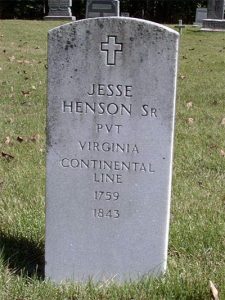
Revolutionary War Solider:
Jesse Henson of Marshall County, Kentucky
Written by Justin D. Lamb
Two hundred and forty one years ago today, the 13 original American colonies officially declared their independence from the British crown with the adoption of the Declaration of Independence. After years of mounting tensions between the colonists and the British Empire over taxation and the lack of political representation, the colonists now regarded themselves as a new nation: the United States of America.
By the summer of 1776, the War for Independence was in full swing as 34,000 British troops were sent by King George III to squash the uprising and reclaim British territory. Thousands of able-bodied men throughout the colonies picked up whatever arms they had available and answered the call to resist the British Red Coats either in their local militia or the regular Continental Army.
One young man, seventeen year old Jesse Henson was living on the Holston River in backwoods of Virginia when the War for Independence broke out that summer of 1776. By September, Henson had joined the Continental Army under Lieutenant George Hart. Henson soon fell under the command of Colonel William Christian who was ordered to contend with the Cherokee tribes who were fighting alongside the British army against the colonists. According to Jesse Henson’s pension application, “Colonel Christian marched his forces at the head of the Tennessee River where they laid waste to the Indian country, burnt up their villages, and destroyed their corn.” As the year 1777 drew near, Henson re-enlisted for an additional year service under Captain Evan Shelby and was stationed at the Fort of Long Islands at Holston River, Virginia where they established a line of defense against Indian forces. Henson was given the duty as a scout where he watched the movements of the Indian tribes before being discharged in 1778.
As the Americans suffered a great number of setbacks and defeats in 1780, Lord Charles Cornwallis moved his British troops to the southern colonies of Georgia, North Carolina, and South Carolina. In September 1780, Jesse Henson returned to service under Captains Campbell and King and marched over the Yellow Mountain into North Carolina towards Kings Mountain. The American forces scored a decisive victory over loyalist forces in the Battle of Kings Mountain on Oct. 7, 1780, but Jesse Henson was unable to participate in the battle after badly spraining his ankle and foot. Henson’s next engagement in the war came three months later, when he marched with Colonel John Sevier into the frontier of North Carolina where they engaged the Cherokee Tribe. In 1781, Henson volunteered under Colonel Millar Major Gray to attack the Cherokee Tribe of the Blue Ridge Mountains in North Carolina and he soon became a spy where he constantly tracked and monitored the movement of the nearby tribes.
As the Revolutionary War drew to a close and America’s independence was finally secured in 1783, Henson was serving at Ashley Station on the frontier of Virginia. On Aug. 16, 1782, Henson was married by George Ledbetter, a Justice of the peace, to Mary “Polly” Goodbread, a daughter Revolutionary War solider Phillip Goodbread Sr. and his wife Catherine. By the year 1801, Henson settled into the wilderness frontier of Kentucky and served in the Corn Stalk Militia in Warren County, Kentucky, which was formed in response to the constant Indian attacks and the exposed situation of the country. By the 1820s, Henson came to the Jackson Purchase region settling in the northern section of Calloway County (now Marshall County) near present day Solider Creek. Eleven months after the formation of Marshall County, Jesse Henson died at age 84 on May 10, 1843, and was buried in the Solider Creek Cemetery.
